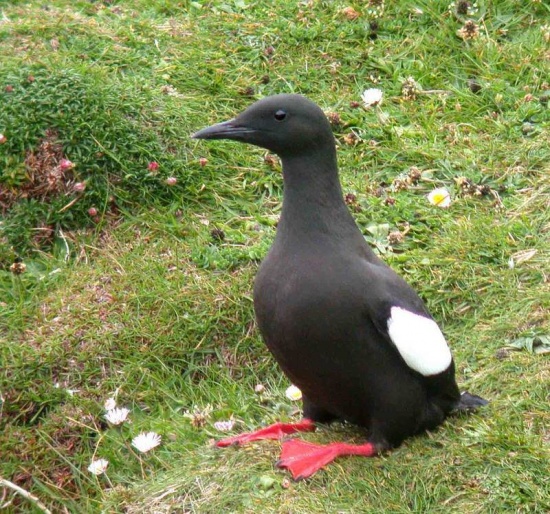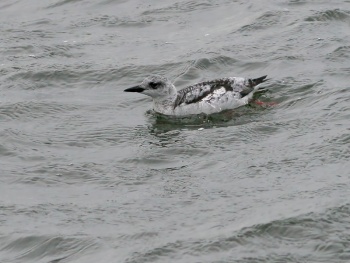Nutcracker (talk | contribs) (more details) |
Nutcracker (talk | contribs) (more details) |
||
| Line 3: | Line 3: | ||
;[[:Category:Cepphus|Cepphus]] grylle | ;[[:Category:Cepphus|Cepphus]] grylle | ||
==Identification== | ==Identification== | ||
| − | + | Length 33 cm, wingspan 53 cm, weight 430 g | |
| − | |||
| − | |||
*Chunky | *Chunky | ||
*Round-winged seabird | *Round-winged seabird | ||
| − | '''Adult''' | + | '''Adult summer''' |
*All black except white upperwing coverts | *All black except white upperwing coverts | ||
*Bright red legs and gape | *Bright red legs and gape | ||
| + | '''Adult winter and juvenile''' | ||
| + | *Mainly white, mottled black above; much whiter above than any other Atlantic Ocean auk | ||
====Similar Species==== | ====Similar Species==== | ||
| − | Appearance, voice, and | + | Appearance, voice, and behaviour almost identical to [[Pigeon Guillemot]]. |
==Distribution== | ==Distribution== | ||
[[Image:21IMG 0470bo.JPG|thumb|350px|right|Photo by {{user|IanF|IanF}}<br />Winter plumage<br /> | [[Image:21IMG 0470bo.JPG|thumb|350px|right|Photo by {{user|IanF|IanF}}<br />Winter plumage<br /> | ||
South Gare, Redcar, Cleveland [[UK]], January 2007 ]] | South Gare, Redcar, Cleveland [[UK]], January 2007 ]] | ||
| − | '''Breeds''' in [[Iceland]] and the [[Faroes]], Jan Mayen, Bear Island, [[Svalbard]] and Franz Josef Land, north and west [[ | + | '''Breeds''' in [[Greenland]], [[Iceland]] and the [[Faroes]], Jan Mayen, Bear Island, [[Svalbard]] and Franz Josef Land, north and west [[Britain]] and [[Ireland]], around the north coasts of the [[Baltic]] and islands in the Kattegat, coastal [[Norway]] to the Murmansk Coast and the White Sea, and on Kolguyev and Novaya Zemlya. They also breed in northeastern [[North America]], from Ellesmere Island, [[Canada]], south to [[Maine]], [[USA]]. |
| − | Most populations are resident with little or no movement away from breeding sites but in the far north most birds move southwards. Birds from [[Finland]] and Gulf of Bothnia '''winter''' mainly off south-east [[Sweden]]. Occasionally seen south of main range in winter, annually recorded in [[Netherlands]], more rarely south to northern [[France]] and [[Belgium]] and exceptionally recorded in [[Czechoslovakia]] and [[Yugoslavia]]. Recently recorded off [[Spain]] | + | Most populations are resident with little or no movement away from breeding sites but in the far north most birds move southwards. Birds from [[Finland]] and Gulf of Bothnia '''winter''' mainly off south-east [[Sweden]]. Occasionally seen south of main range in winter, annually recorded in [[Netherlands]], more rarely south to northern [[France]] and [[Belgium]] and exceptionally recorded in [[Czechoslovakia]] and [[Yugoslavia]]. Recently recorded off [[Spain]]. |
==Taxonomy== | ==Taxonomy== | ||
| − | Five races occur in the region but separation at sea is rarely possible.<br /> Most distinctive is ''mandtii'' from Jan Mayen, Bear Island and [[Svalbard]], with whiter upperparts in non-breeding plumage. Remaining races, nominate ''grylle'' from the Baltic, ''arcticus'' from [[British Isles]] to | + | Five races occur in the region but separation at sea is rarely possible.<br /> Most distinctive is ''C. g. mandtii'' from Jan Mayen, Bear Island and [[Svalbard]], with whiter upperparts in non-breeding plumage. Remaining races, nominate ''C. g. grylle'' from the Baltic, ''C. g. arcticus'' from [[British Isles]] to arctic [[Russia]], ''C. g. faroeensis'' from [[Faroes]] and ''C. g. islandicus'' from [[Iceland]] are all very similar, differing only in minor measurements. |
==Habitat== | ==Habitat== | ||
[[Image:5984black-guillemotbf.jpg|thumb|350px|right|Photo by {{user|psilo|psilo}}<br />Southern [[Ireland]], June 2006]] | [[Image:5984black-guillemotbf.jpg|thumb|350px|right|Photo by {{user|psilo|psilo}}<br />Southern [[Ireland]], June 2006]] | ||
| Line 29: | Line 29: | ||
They breed singly or in small scattered colonies and lay their eggs in rocky crevices near water. | They breed singly or in small scattered colonies and lay their eggs in rocky crevices near water. | ||
====Diet==== | ====Diet==== | ||
| − | The diet includes fish and crustaceans, molluscs, | + | The diet includes fish and crustaceans, molluscs, and cephalopods. |
====Vocalisation==== | ====Vocalisation==== | ||
A weak high-pitched whistle | A weak high-pitched whistle | ||
Revision as of 21:51, 14 November 2014
Alternative name: Tystie
- Cepphus grylle
Identification
Length 33 cm, wingspan 53 cm, weight 430 g
- Chunky
- Round-winged seabird
Adult summer
- All black except white upperwing coverts
- Bright red legs and gape
Adult winter and juvenile
- Mainly white, mottled black above; much whiter above than any other Atlantic Ocean auk
Similar Species
Appearance, voice, and behaviour almost identical to Pigeon Guillemot.
Distribution
Breeds in Greenland, Iceland and the Faroes, Jan Mayen, Bear Island, Svalbard and Franz Josef Land, north and west Britain and Ireland, around the north coasts of the Baltic and islands in the Kattegat, coastal Norway to the Murmansk Coast and the White Sea, and on Kolguyev and Novaya Zemlya. They also breed in northeastern North America, from Ellesmere Island, Canada, south to Maine, USA.
Most populations are resident with little or no movement away from breeding sites but in the far north most birds move southwards. Birds from Finland and Gulf of Bothnia winter mainly off south-east Sweden. Occasionally seen south of main range in winter, annually recorded in Netherlands, more rarely south to northern France and Belgium and exceptionally recorded in Czechoslovakia and Yugoslavia. Recently recorded off Spain.
Taxonomy
Five races occur in the region but separation at sea is rarely possible.
Most distinctive is C. g. mandtii from Jan Mayen, Bear Island and Svalbard, with whiter upperparts in non-breeding plumage. Remaining races, nominate C. g. grylle from the Baltic, C. g. arcticus from British Isles to arctic Russia, C. g. faroeensis from Faroes and C. g. islandicus from Iceland are all very similar, differing only in minor measurements.
Habitat
Colonial breeder in boulder piles at the base of cliffs and on scree-covered slopes on low rocky islands and coasts. Winters mainly in sheltered bays close to breeding site.
Behaviour
Not particularly sociable, rarely seen in large groups or with other auks.
Breeding
They breed singly or in small scattered colonies and lay their eggs in rocky crevices near water.
Diet
The diet includes fish and crustaceans, molluscs, and cephalopods.
Vocalisation
A weak high-pitched whistle
<flashmp3>Cepphus grylle (song).mp3</flashmp3>
Listen in an external program
In culture
The alternative name Tystie, popular in Britain, is an Old Norse name, cognate with the species' name in most Scandinavian countries (Danish Tejst, Faeroese Teisti, Norwegian Teiste, Icelandic Teista).






